The Question
How would you estimate revenue generated by Google AdSense?
How Are You Being Evaluated
In this product management interview question, the interviewer is assessing your ability to provide quick estimates related to a product. The estimation could be about revenue, the number of users, or something else. Why is the interviewer asking you to do this? Because as a product manager you may need to estimate the size of a new market or revenue, or any other business opportunity, to convince stakeholders of a new idea. Therefore, this is an essential skill.
The interviewer is evaluating you on the following:
- Are you methodical and articulate when explaining your estimation approach?
- Is the interviewer able to follow you when you make calculations?
- Can you make calculations quickly?
- Do you explain your assumptions convincingly?
The key to answering estimation questions is to separate the “how-to” from the calculations. Separating operations from calculations prevents the interviewer and you from getting lost in calculations and losing track of what you are calculating. An estimation tree does this. Using an estimation tree allows you to explain your logic behind the operations first, to then focus solely on calculations.
Answer Structure
Here is how to structure the answer:
- Ask clarifying questions to agree on the scope of the estimation.
- Explain a top line equation. Introduce a top line equation to explain your overall approach.
- State your assumptions.
- Draw an estimation tree. Label the top component with the result you want to get and the time range it covers (e.g., a year). Break down the root component into sub-components (A, B, C) that you aggregate with arithmetic operators. Explain your logic behind the arithmetic operations For example, why are you multiplying A times B and dividing by C? Explain any assumptions using something that is common knowledge or a familiar scenario that the interviewer is likely to agree with. Repeat this step if you need to break down a component into additional sub-components.
- Calculate from the bottom up. Start at the base of the tree and calculate results for each component branch until you reach the top component (the result you want to get).
- Do a sanity check. Check whether your estimation is in the ballpark by comparing it with a benchmark you know. If your estimate is not in the ballpark, check your assumptions, identify which one is wrong, and explain a possible cause for the miscalculation to the interviewer. As long as you have an explanation, your answer will be well received.
Answer Example
Ask Clarifying Questions
INTERVIEWEE: I would like to start by clarifying my understanding of how Google AdSense generates revenue.
INTERVIEWER: Sure.
INTERVIEWEE: Google AdSense is a Google advertising solution for publishers, and it is only for third-party websites, right?
INTERVIEWER: Yes. It does not include Google properties like YouTube for example.
INTERVIEWEE: Okay, and the way Google AdSense works is that it enables publishers to offer ad space on their properties by allowing marketers to bid for those spaces?
INTERVIEWER: Yes.
INTERVIEWEE: Okay. I know that publishers get a share of the bid, so should the estimate exclude this share?
INTERVIEWER: No. Estimate the entire AdSense revenue, including the publishers’ share, which by the way is called the Traffic Acquisition Cost.
INTERVIEWEE: Got it, thank you. Should I assume this is a one year estimate?
INTERVIEWER: Yes.
INTERVIEWEE: May I have a minute to think about how to approach this estimation question?
INTERVIEWER: Sure.
Explain a Top Line Equation
(The Interviewee takes a minute to write down how to estimate Ad Revenue for one year and breaks the estimate down into components: number of publishers, revenue per day per publisher, and 365 days.)
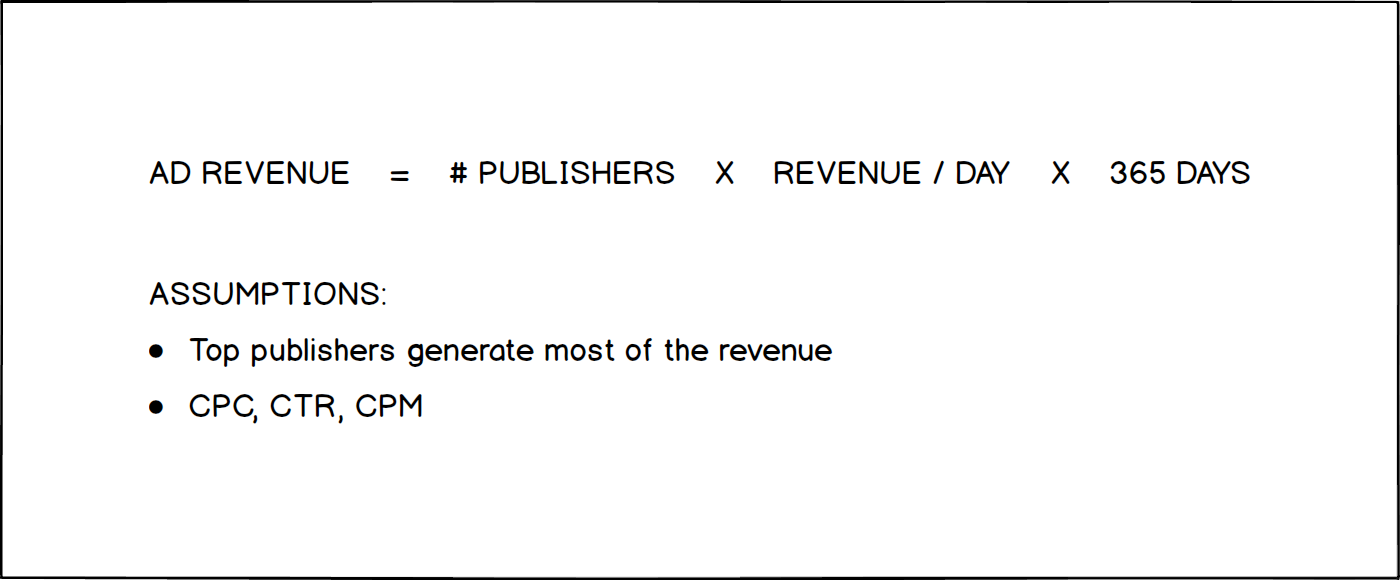
INTERVIEWEE: (The interviewee explains how to approach the estimation using a whiteboard or piece of paper.)
Okay, at a high level, here is how I would approach this estimation. Many publishers use Google AdSense to sell ad space on their sites and make yearly revenue from these ads. So, I will estimate total ad revenue in one year by multiplying the number of publishers, times the average daily ad revenue per publisher, times the number of days in a year.
Before explaining the details of how I will estimate the number of publishers and daily revenue, I want to confirm — is my approach clear so far?
INTERVIEWER: So far, yes.
State Your Assumptions
INTERVIEWEE: Okay. Based on my general knowledge of digital publishers, I know that the top 100 online publishers range from the most popular, like The New York Times to the niche publisher like Popular Mechanics. The New York Times has around 10M subscribers, and I assume most of them are daily readers. While a publisher like Popular Mechanics has about 10,000 subscribers that read it once a month. So, given that the niche publishers are at the bottom of the top 100, I can safely assume that overall these 100 publishers represent close to 100% of the Google AdSense revenue. I say almost because I am not counting individual bloggers that use Google AdSense. Would you agree with this assessment?
INTERVIEWER: Seems reasonable, please continue.
INTERVIEWEE: Okay. From memory, I can list at most 20 online publishers like The New York Times, Huffington Post, CNN, and others. And like The New York Times, these publishers draw daily subscribers in the millions, while niche publishers draw subscribers in the thousands that read them monthly. So, I think we can apply the 20/80 rule here, whereby 20% of the top publishers are likely generating 80% of the AdSense revenue. Does this sound reasonable to you?
INTERVIEWER: Yes. So how will you use this information?
Draw an Estimation Tree
INTERVIEWEE: (The interviewee starts drawing an estimation tree. As each branch is sketched, the interviewee walks the interviewer through the tree and explains the components.)
Okay, since I am using the 20/80 rule, my estimation is for 80% of Google AdSense revenue generated by the top 20% of publishers (the root component).
So I will multiply 20, which represents to the top 20% of the top 100 publishers, times the average revenue they generate in a day, times 365 days (first level of branches).
Next, I decompose ad revenue for a day into revenue from click ads and impression ads, which are the main ad types offered by Google AdSense (second level of branches).
Then to calculate the ad revenue from click ads for a day, I will multiply the number of visitors per day, times the number of click ads seen by a visitor, times the percentage of those ads that the user clicks on, which is the click-through-rate (CTR), times the cost-per-click (CPC) (third level of branches).
And to calculate the number of click ads seen by a visitor in 1 day, I will calculate the number of pages visited in a day times the number of ads per page times the percentage of those ads that are click-ads (fourth level of branches).
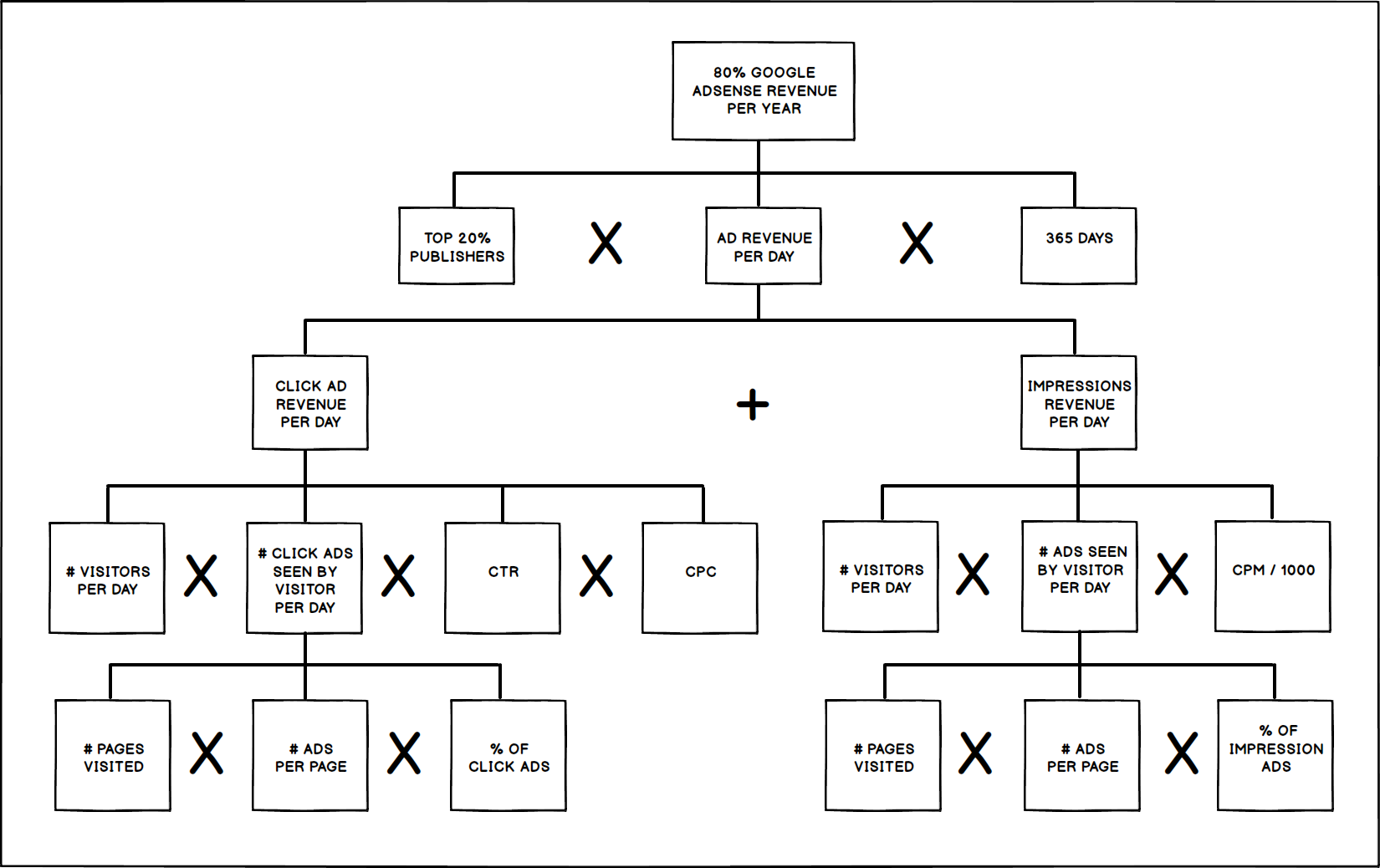
Do you have any questions so far?
INTERVIEWER: No, go ahead.
INTERVIEWEE: Okay, here is how I will calculate the impressions side of the ad revenue (second level, right branch). To calculate the ad revenue from impression ads for a day, I will multiply the number of visitors per day, times the number of impression ads they see per day, times the cost per impression, which is equal to the cost per thousand impressions divided by 1000 (CPM/1000).
And to calculate the number of impression ads seen by a visitor in one day, similar to the calculation with click ads, I will multiply the number pages a person visited a page per day times the number of ads per page times the percentage of those ads that are impression ads.
Do you have any questions so far?
INTERVIEWER: No, it is clear to me. Let’s move on to getting a total estimation.
INTERVIEWEE: Sure.
Calculate From The Bottom Up
Last Branch, Left Side
Okay. Starting at the bottom left of the estimation tree, I will begin by estimating the number of pages visited per day by a reader. Since I subscribe to The New York Times, I am going to use myself as your average reader to this estimation.
I read The New York Times daily, usually in the mornings for about 30 minutes and during breaks throughout the day. On average, I read about ten news articles or pages a day. So, I will use 10 for the number of pages visited per day.
(The interviewee used a typical scenario that the interviewer is likely familiar with to explain the assumptions. Next, the interviewee writes down the estimated numbers at the top left corner of the component. The interview repeats this process for calculating every component.)
Now, I figure I see at least five ads per page. So, I will put down 5 as the number of ads per page. And, I am going to assume that on average 50% of the ads I see are clickable and 50% are impression ads. It is the best guess given that marketers frequently use both ad types. So, I will put down 0.5 or 50% as the percentage of click ads. Okay. Now, I can multiply these numbers to obtain the number of click ads seen by a visitor in one day: 10 x 5 x 0.5 equals to 25.
(The interviewee rights down 25 at the top left corner of the component labeled click ads seen by a visitor in one day.)
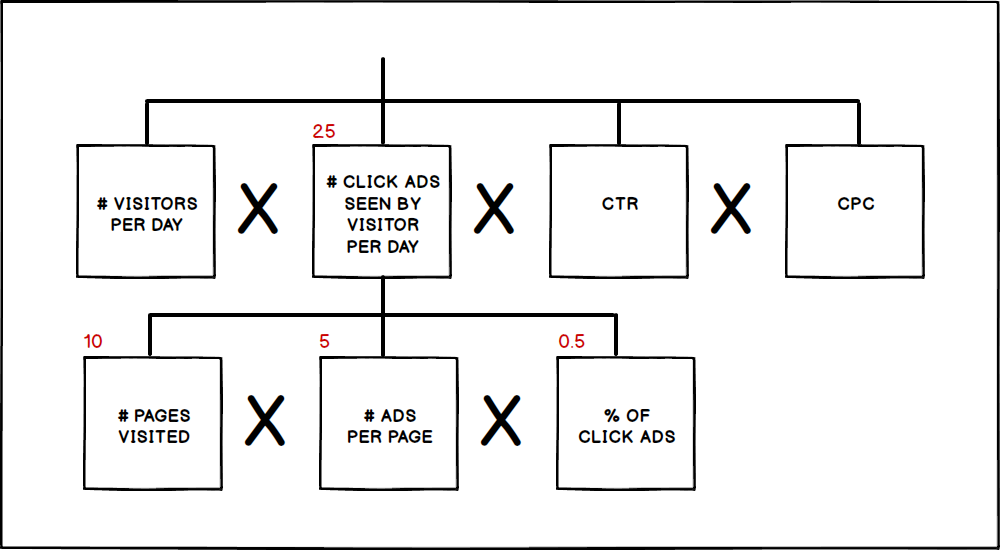
Third Level Branch, Left Side
Now, let’s move up to the parent branch. Of the top 20 publishers, The New York Times is one of the most popular publishers in the United States and has about 10M subscribers. So, I will consider this the max range for subscribers. The rest of the top 20 publications will also have subscribers in the millions but less than The New York Times. So, let’s say the range of subscribers is between 1 and 10 million. Given no other data point to go by, I am going to take the average, 5M, as the average number of subscribers of these publishers. Since these subscribers are likely to visit their subscriptions daily, I will assume that this is also the number of visitors per day.
(The interviewee writes down 5M at the top left corner of the visitors per day component.)
Moving on to CTR. I will assume an average rate of 0.5% and for CPC an average rate of $0.5. These are two common averages for digital display ads. So now, we can multiply the number of visitors per day times the 25 click ads seen by a visitor per day times CTR times CPC to calculate the click ad revenue per day, 5M X 25 X 0.5% X $0.5, which is $0.3M per day.
(The interviewee writes down $0.3M on the left top corner of the click ad revenue per day component.)
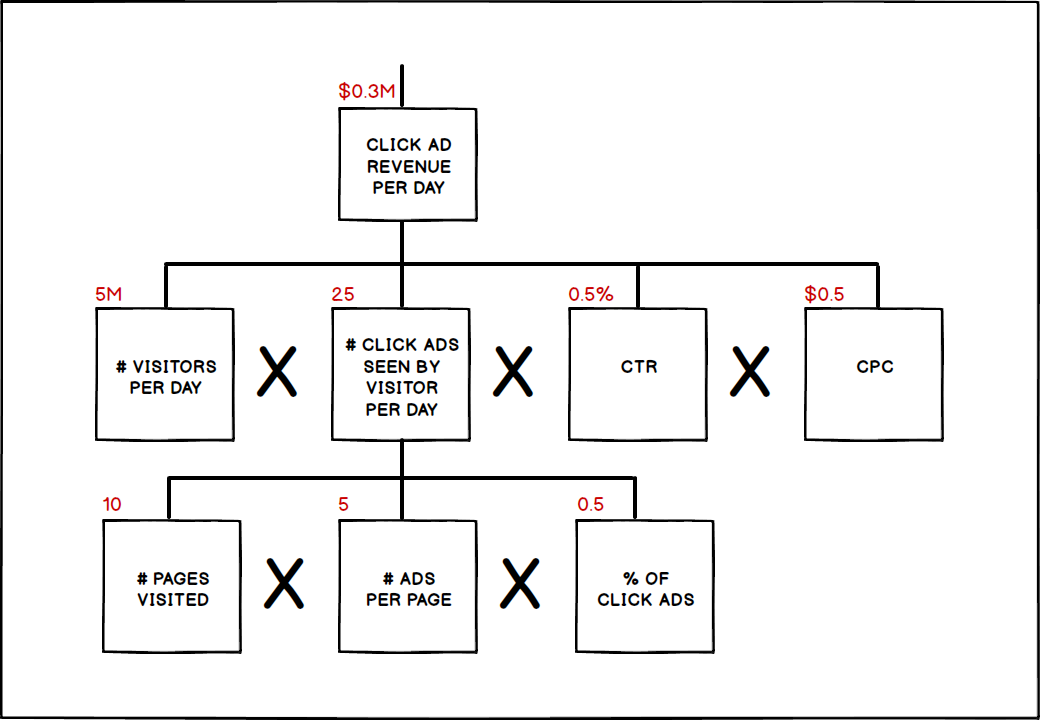
Last Branch, Fourth Level, Right Side
Okay. Now, I am going to move to the right side of the estimation tree and calculate impression ads revenue per day. Similar to click ads, I will start at the bottom of the tree. On this branch, all the estimates for the components are the same as the ones for click ads because the number of pages visited by a reader per day is the same regardless of what kind of ads are on the page. The same goes for the number of ads per page. And, I assumed that the other 50% of ads are impression ads. So, the number of ads seen by a visitor per day is 25.
(The interviewee writes down 25 on the top left corner of ads seen by a visitor per day component.)
Third Level Branch, Right Side
Now, let’s move up one branch. The number of visitors per day is the same as in click ads, 5M. For the number of ads seen by a visitor, we calculate it to be 25. And, based on my knowledge of average CPM for display ads, my estimate is $1. So, to derive revenue for impressions per day, I will multiply these three components, 5M visitors/day X 25 impression ads seen X $0.001 per impression. This is equal to about $0.13M
(The interviewee writes down $0.13M on the top left corner of the impressions revenue per day component.)
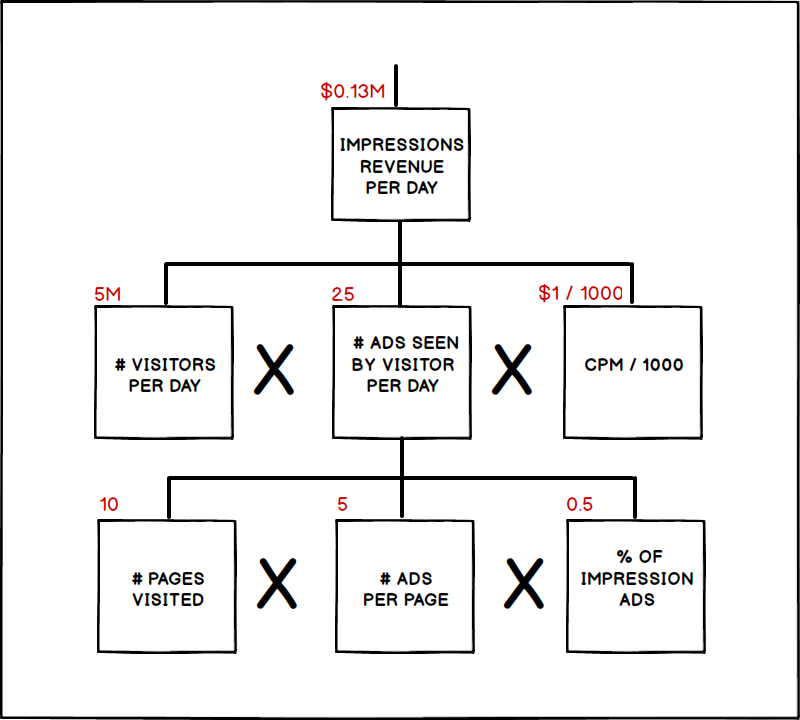
Second Level Branches
Okay, now I will add $0.3M from click ad revenue per day and $0.13M from impressions revenue per day to calculate ad revenue per day. So, $0.3M + $0.13M adds up to $0.4M for ad revenue per day.
(The interviewee writes $0.4M at the top left corner of the ad revenue per day component.)
We now have all the numbers to estimate 80% of Google AdSense revenue per year. So, 20% of the top 100 publishers is 20, times $0.4M of ad revenue per publisher per year, times 365 days. The calculation results in $2.9 billion, which means that the total Google AdSense revenue in a year is $2.9 billion / 80% which is about $3.6 billion.
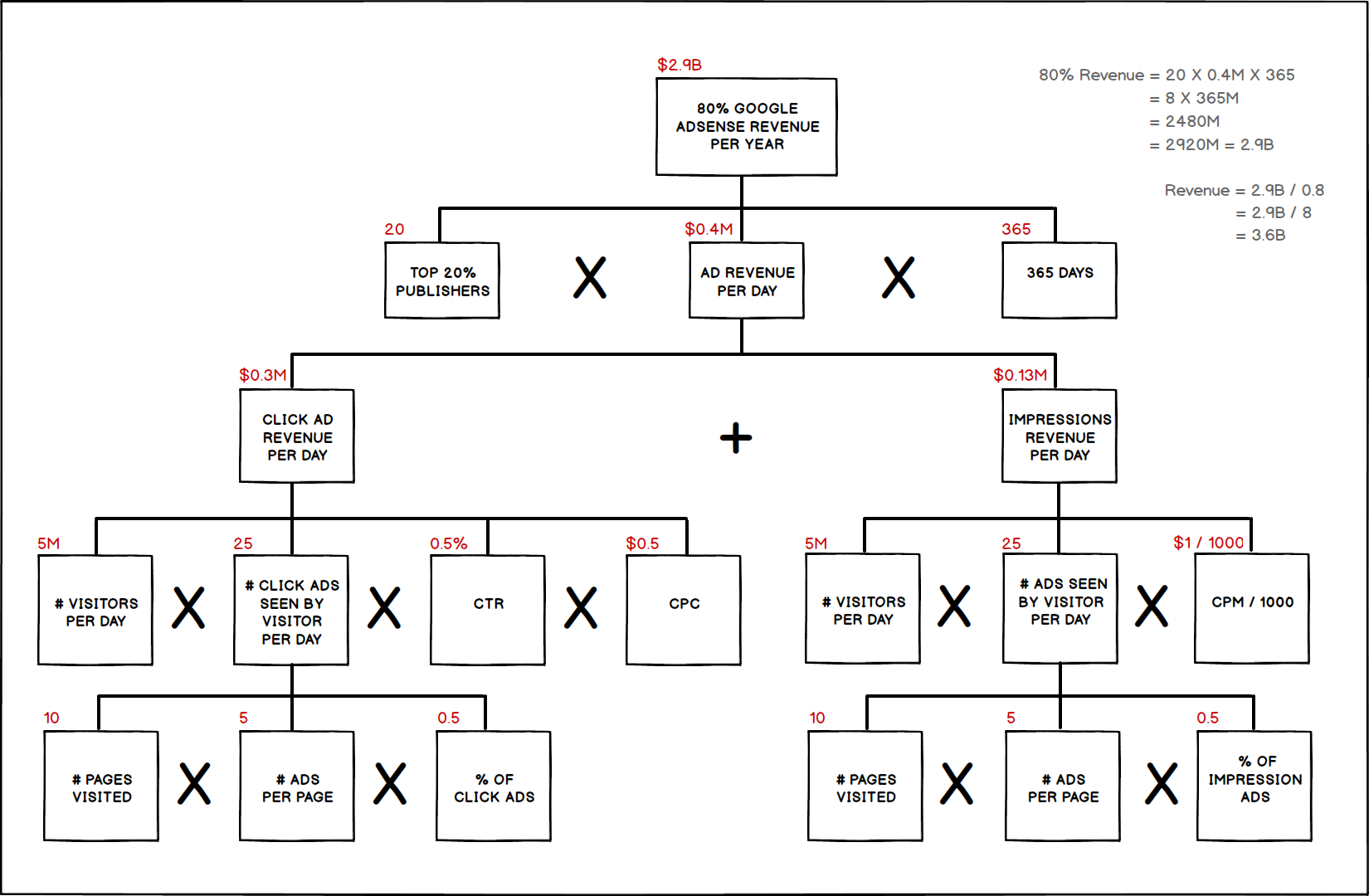
INTERVIEWER: Okay, so how do you feel about your estimate? Do you think it is in the ballpark?
Do A Sanity Check
INTERVIEWEE: Well, I think the estimate is much lower than what the Google AdSense revenue actually is. From my reading of Alphabet’s last 10K Annual Report, I know that income from Google Network Member properties is about $17B, so I am off by a factor of about 4.
INTERVIEWER: How can you explain that?
INTERVIEWEE: I think that my assumption that only subscribers are daily readers was too conservative. In fact, the majority of people that visit these publishers are probably not subscribers. They are most likely visitors that do not want to pay for subscriptions, yet they want to read these publishers’ content. So, I am guessing that the ratio between non-subscribers to subscribers that visit these publishers is probably is 4:1, and this explains the discrepancy.
INTERVIEWER: Yes, that makes sense. So how would you change your calculations?
INTERVIEWEE: Instead of 5M visitors per day, I would change it to 5M x 4 or 20M. With this change, my results would have been about $16B, which is not too far off from the $17B in the 10K.
INTERVIEWER: Great, thank you.
